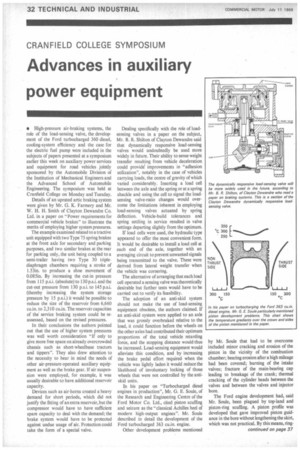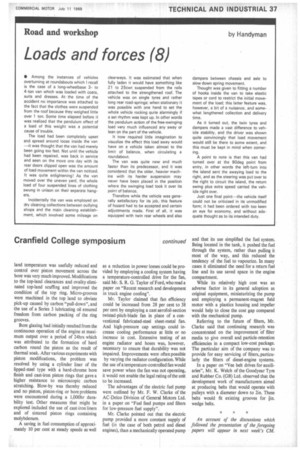CRAN FIELD COLLEGE SYMPOSIUM
Page 34

Page 39

If you've noticed an error in this article please click here to report it so we can fix it.
Advances in auxiliary power equipment
• High-pressure air-braking systems, the role of the load-sensing valve, the development of the Ford turbocharged 360 diesel, cooling-system efficiency and the case for the electric fuel pump were included in the subjects of papers presented at a symposium earlier this week on auxiliary power services and equipment for road vehicles jointly sponsored by the Automobile Division of the Institution of Mechanical Engineers and the Advanced School of Automobile Engineering, The symposium was held at Cranfield College on Monday and Tuesday.
Details of an uprated artic braking system were given by Mr. G. K. Farmery and Mr. W. H. H. Smith of Clayton Dewandre Co. Ltd. in a paper on "Power requirements for commercial vehicle brakes" to illustrate the merits of employing higher system pressures.
The example examined related to a tractive unit equipped with two Type 75 spring brakes at the front axle for secondary and parking purposes, and two similar brakes at the rear for parking only, the unit being coupled to a semi-trailer having two Type 30 triple
diaphragm chambers requiring a stroke of 1.53in. to produce a shoe movement of 0.085in. By increasing the cut-in pressure from 115 p.s.i. (absolute) to 130 p.s.i. and the cut-out pressure from 110 p.s.i. to 145 p.s.i. (thereby increasing the system storage pressure by 15 p.s.i.) it would be possible to reduce the size of the reservoir from 6,660 cu.in. to 2,310 cu.in. The reservoir capacities of the service braking system could be reassessed, based on the revised pressures.
In their conclusions the authors pointed out that the use of higher system pressures was well worth consideration "If only to give more free space on already overcrowded chassis such as short-wheelbase tractors and tippers". They also drew attention to the necessity to bear in mind the needs of other air-pressure-operated auxiliary equipment as well as the brake gear_ If air suspension were employed, for example, it was usually desirable to have additional reservoir capacity.
Devices such as air-horns created a heavy demand for short periods, which did not justify the fitting of an extra reservoir, but the compressor would have to have sufficient spare capacity to deal with the demand; the brake system would have to be protected against undue usage of air. Protection could take the form of a special valve. Dealing specifically with the role of loadsensing valves in a paper on the subject, Mr. B. R. Shfiton of Clayton Dewandre said that dynamically responsive load-sensing valves would undoubtedly be used more widely in future. Their ability to sense weight transfer resulting from vehicle deceleration could provide' improvements in "adhesion utilization", notably in the case of vehicles carrying loads, the centre of gravity of which varied considerably. Inserting a load cell between the axle and the spring or at a spring shackle and using the cell to signal the load sensingvalve-ratio changes would overcome the limitations inherent in employing load-sensing valves actuated by spring deflection. Vehicle-build tolerances and spring settling in service resulted in valve settings departing slightly from the optimum.
If load cells were used, the hydraulic type appeared to offer the most convenient form. It would be desirable to install a load cell at each end of the axle, together with an averaging circuit to prevent unwanted signals being transmitted to the valve. These were derived from lateral weight transfer when the vehicle was cornering.
The alternative of arranging that each load cell operated a sensing valve was theoretically desirable but further tests would have to be carried out to verify its feasibility.
The adoption of an anti-skid system should not make the use of load-sensing equipment obsolete, the authors claimed. If an anti-skid system were applied to an axle that was grossly overbraked relative to the load, it could function before the wheels on the other axles had contributed their optimum proportions of the total vehicle retarding force, and the stopping distance would thus be increased. Load-sensing equipment would alleviate this condition, and by increasing the brake pedal effort required when the vehicle was lightly laden it would reduce the likelihood of involuntary locking of those wheels that were not controlled by the antiskid units.
In his paper on "Turbocharged diesel engines in production", Mr. G. E. Soule, of the Research and Engineering Centre of the Ford Motor Co. Ltd., cited piston scuffing and seizure as the "classical Achilles heel of modern high-output engines". Mr. Soule described in detail the development of the Ford turbocharged 363 cu.in. engine.
Other development problems mentioned by Mr. Soule that had to be overcome included minor cracking and erosion of the piston in the vicinity of the combustion chamber; bearing erosion after a high mileage had been covered; burning of the intake valves; fracture of the main-bearing cap leading to breakage of the crank; thermal cracking of the cylinder heads between the valves and between the valves and injector bore.
The Ford engine development had, said Mr. Soule, been plagued by top-land and piston-ring scuffing. A piston profile was developed that gave improved piston guidance in the bore without lengthening the skirt, which was not practical. By this means, ring land temperature was usefully reduced and control over piston movement across the bore was very much improved. Modifications to the top-land clearances and ovality eliminated top-land scuffing and improved the condition of the top ring. Micro-grooves were machined in the top land to obviate pick-up caused by carbon "pull-down", and the use of a Series 3 lubricating oil ensured freedom from carbon packing of the ring grooves.
Bore glazing had initially resulted from the continuous operation of the engine at maximum output over a period of 24hrs which was attributed to the formation of hard carbon round the piston as the result of thermal soak. After various experiments with piston modifications, the problem was resolved by using a cylinder liner of the lipped-steel type with a hard-chrome bore finish and cast-iron piston rings that gave a higher resistance to microscopic carbon scratching. Blow-by was thereby reduced and no piston, piston-ring or bore problems were encountered during a 1.000hr durability test. Other measures that might be explored included the use of cast-iron liners and of sintered piston rings containing molybdenum.
A saving in fuel consumption of approximately 10 per cent at steady speeds as well as a reduction in power losses could be provided by employing a cooling system having a temperature-controlled drive for the fan, said Mr. S. R. G. Taylor of Ford, who read a paper on "Recent research and development in truck engine cooling".
Mr. Taylor claimed that fan efficiency could be increased from 28 per cent to 38 per cent by employing a cast aerofoil-section twisted-pitch-blade fan in place of a conventional fabricated-steel sheet-metal fan. And high-pressure cap settings could increase cooling performance at little or no increase in cost. Extensive testing of an engine radiator and hoses was, however, necessary to ensure that durability was not impaired. Improvements were often possible by varying the radiator configuration. While the use of a temperature-controlled fan would save power when the fan was not operating, it would not enable the legal rating of the unit to be increased.
The advantages of the electric fuel pump were outlined by Mr. F. W. Clarke of the AC-Delco Division of General Motors Ltd. in a paper on "Fuel feed pumps and filters for low-pressure fuel supply".
Mr. Clarke pointed out that the electric pump provided a more constant supply of fuel (in the case of both petrol and diesel engines), than a mechanically operated pump and that its use simplified the fuel system. Being located in the tank, it pushed the fuel through the system, rather than pulling it most of the way, and this reduced the tendency of the fuel to vapourize. In many cases it eliminated the need for a return fuel line and its use saved space in the engine compartment.
While its relatively high cost was an adverse factor in its general adoption as original equipment, miniaturizing the pump and employing a permanent-magnet field motor with a plastics housing and impeller would help to close the cost gap compared with the mechanical pump.
Referring to the future of filters, Mr. Clarke said that continuing research was concentrated on the improvement of filter media to give overall and particle-retention efficiencies in a compact low-cost package. The particular aim of the company was to provide for easy servicing of filters, particularly the filters of diesel-engine systems.
In a paper on "Vee belt drives for auxiliaries", Mr. K. Welch of the Goodyear Tyre and Rubber Co. (GB) Ltd. observed that the development work of manufacturers aimed at producing belts that would operate with pulleys with a diameter down to 2in. These belts would fit existing grooves for gin. wedge belts.
An account of the discussions which followed the presentation of the foregoing papers will appear in next week's CM.












































































































